#Tree Identification
Explore tagged Tumblr posts
Text

53 notes
·
View notes
Text
Sphenopsida
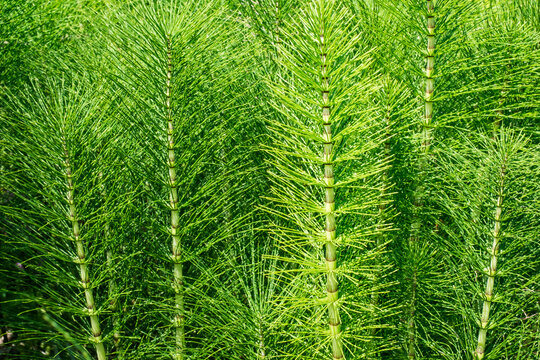
-- often called "horsetails"
-- tracheophytes
-- only 25 living species
-- true land plants
-- vascular
-- true roots, stems, and leaves
-- small leaves
-- scale-like pattern on leaves
-- grow in tropical and temperate climates
-- use alteration of generations
-- cell walls in leaves and stems contain silica
.
Patreon
#studyblr#notes#botany#biology#bio#bio notes#biology notes#botany notes#taxonomy#classification#my notes#trees#dendrology#dendrology notes#life science#science#tree identification#gardening#plants#plant identification#tree health#ecology#forestry#environment#environmental science#environmental protection#environmental services#note cards#flashcards
22 notes
·
View notes
Text
tree identification?
so long story short I have some wood and not any certainty on what type of wood it is, even after spending about 4 hours teaming up with someone with a tree identification book, a PDF from a forestry commission, and like three websites
The closest ive figured is that it might be a species of elm? but im open to more input.








The characteristic that's not apparent from looking is that the wood is fairly easy to carve with a utility knife. I have some green soft maple, and it seemed to be about that easy to work with. Much easier to carve than both walnut and white oak.
It is NOT black cherry, there's an app that uses photos to try and identify the wood and it keeps saying black cherry, but it's wrong XD
Characteristics: deciduous hardwood, tall with straight trunk. leaves are simple and alternating, with an even number of leaves per twig. grows in the southeastern united states, roughly as far south as Atlanta, GA. no noticeable scent to wood.
#tree#tree identification#its so hard to get a picture of leaves with the tree is FUCKING TALL#and has no lower limbs in grabbing range!!!#during Tree Quest i also learned there's a persimmon tree in the woods 8D
9 notes
·
View notes
Text
To lift the spirit, here's a video I took today of one of my favorite trees. This one is on my parent's property. His low branches remind me of tusks.

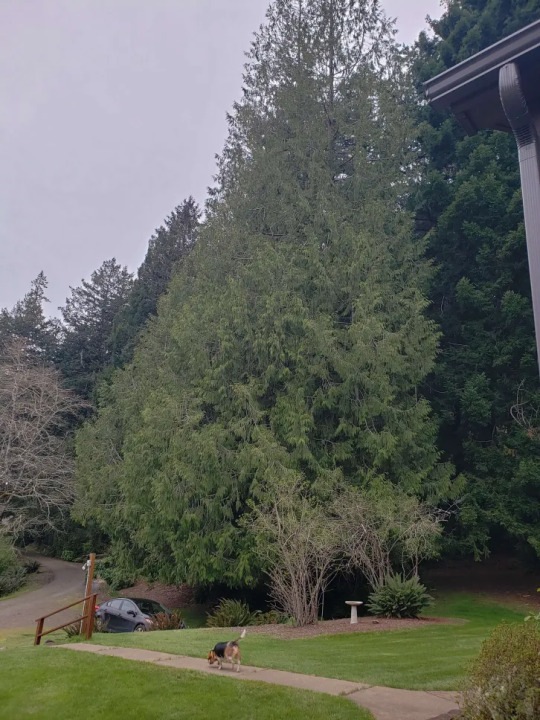
My parent's dog and my car for size reference.
#tree#trees#nature#I would love to know what kind of tree this is#if anyone could identify it#I'm better with birds and fish :'/#really sad I had to leave today#I also miss their dog lol#tree identification#nature identification#dendrology#arborist
7 notes
·
View notes
Text
Winter Trees and Shrubs: Box Elder
Box elder is a maple that doesn’t often get credit for being a maple. Moreso, it is a tree that is not thought highly of, and it may not even be welcome in certain discussions around maples. You could even say that box elder is a “rogue maple,” as Arthur Plotnick deems it in The Urban Tree Book. It should come as no surprise, but if people are going to talk about a plant this way, it’s only going…

View On WordPress
#Acer negundo#Arthur Plotnick#ash trees#bark#Boise Idaho#Botany#box elder#horticulture#John Eastman#native trees#tree identification#urban ecology#weedy trees#Winter Botany#winter buds#Winter Trees and Shrubs#winter twigs
17 notes
·
View notes
Text










While on my bike ride I found a lot of this kind of tree in bloom. They smell delightful, but I only ever find them cultivated. Does anyone know what they are? Anyway I shot some pics I hope yall think are pretty.
#urban nature#nature#trees#golden hour#jesus christ#flowers#plants#floral#flora#tree id#tree identification
3 notes
·
View notes
Text

#naturecore#my photgraphy#photogtraphers on tumblr#autumn trees#autumn foliage#nature#skycore#clouds#treecore#treescape#trees#tree identification
4 notes
·
View notes
Text
Leaves or needles, bark, fruit, and climate can all help you identify what kind of tree you've climbed into to for that sweet, sweet
HIGH GROUND ADVANTAGE

Colorado’s major tree species include bristlecone pine, Colorado blue spruce, Douglas-fir, Engelmann spruce, limber pine, lodgepole pine, narrowleaf cottonwood, quaking aspen, piñon pine, plains cottonwood, ponderosa pine, Rocky Mountain juniper, subalpine fir and white fir.
Learn to identify these trees and more with this handy guide from the Colorado State Forest Service:
COLORADO'S MAJOR TREE SPECIES
How faithfully did Guerrilla Games recreate local trees in the Horizon games? There's so much gorgeous detail, I wonder if more than one kind of evergreen is recognizably represented.
If you can distinguish one kind of conifer from another in-game, let me know!
NORA SACRED LAND
ROCKY MOUNTAINS, COLORADO, USA
#my photo#rocky mountains#colorado#horizon zero dawn#gaming tourism#nora sacred land#nora tribe#the nora#botany#trees#tree id#tree identification#guerrilla games#horizon locations#horizon landscapes#game developers#game development#high ground advantage
9 notes
·
View notes
Text
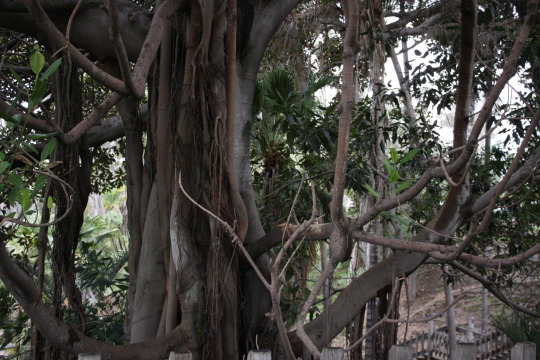
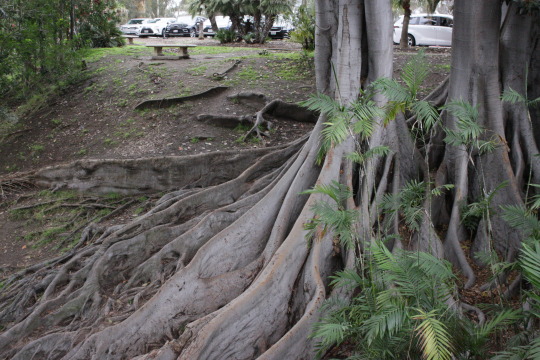
not sure what this tree is called, anyone can ID?
I love how prehistoric this tree is.
#photoblog#photo#photography#photoshoot#beautiful photos#photooftheday#nature photography#nature#forest#trees#landscape#tree identification#trees and forests#branches#roots
19 notes
·
View notes
Text



Pitch Pine (Pinus rigida)
Location: Mount Desert Island, Park Loop Road
Notes: Currently working being able to identify Maine's four native pine species (Eastern white pine, red pine, pitch pine, jack pine). This is pitch pine. ID was based on the rounded "balls" of needles which are so distinctive and cool looking, the smaller size, the rounded, classic cone shape, and the bunches of needles attached directly to the bark.
#plant identification#tree identification#plant id#mount desert island#maine#tree id#plantblr#pitch pine#pine trees#trees
2 notes
·
View notes
Text
Thompson's Yucca Names


Patreon
#studyblr#notes#my notes#biology#bio#trees#tree species#tree characteristics#dendrology#dendrology notes#life science#science#tree identification#botany#botany notes#gardening#plants#plant identification#tree health#ecology#forestry#environment#environmental science#environmental protection#environmental services#note cards#flashcards#flash cards
3 notes
·
View notes
Text
if anyone needs me before the knights game i’ll be over here trying to figure out what kind of trees those blurry ones behind them in the walk in photos are god bless amen
2 notes
·
View notes
Text
Dendrology tumblr, do you guys have any author recommendations for learning how to identify trees in North America, specifically the east coast of the United States? Nothing has scratched the itch on my brain quite like fungi and lichens but I'm always drawing a blank on most trees since I have no idea where to even begin identifying them.
Fake AI generated ID books are probably less of an issue in dendrology compared to mycology, but I'm still pretty wary.
6 notes
·
View notes
Text
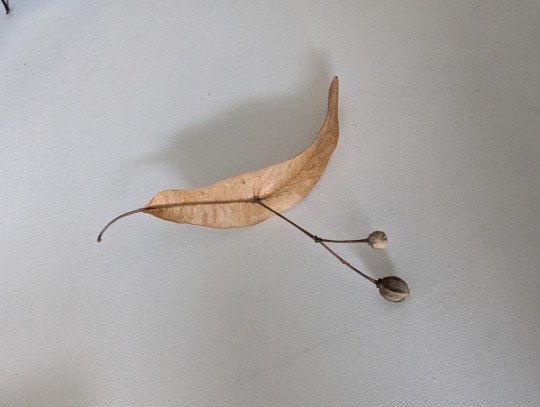
Anybody know what type of tree this is from?
#tree identification#seeds#tree seed#im so hype these blew up onto my balcony and i want to try and grow it
4 notes
·
View notes
Text
Okay. May as well.
American persimmon (Diospyros virginiana) identification guide
Tumblr version! Shared August 2nd, 2023. It will have as much of the guide as tumblr lets me add.
Oh darn, I reached the limit for photos :( Damn it, tumblr.
You can read and download the full guide here on the web archive.
Make sure you click through the available files to pick the one with the newest date!
You can also buy it as a physical book!
The prices for the physical book are set so that I get $20.
(Archived read-more link. Photos may or may not load.)
A note from the author:
I am transgender and nonbinary, which means in my case that I am neither a man nor a woman, and use it/its as my personal pronouns pronouns, which means if you are referring to me when telling others about this guide, you should refer to me as “it” rather than “he”, “she”, or “they”. EX:
“It wrote a guide on how to identify American persimmons,” or
“We can ask it if it thinks this is a persimmon or a pawpaw.” Ect!
If you're talking to me online or IRL, it's still fine to use the pronouns “you” while addressing me :)
Now lets get identifying!
Starting from the ground up, with the seeds.
American persimmon seeds are large, almost flat, and brown, with a slightly bumpy texture. Viable seeds should be a bit puffy in the middle, and the ones with the best chance of growing will be larger. The following photos show seeds that were collected on October 8th, 2022, in Savannah Georgia, from the three mature trees at Mohawk Lake.
Over four hundred seeds were collected, with plenty more fruit on the ground for wildlife, and even more still up on the branches of the tree waiting to ripen and fall. When collecting native fruit from the wild, always leave behind more than you take! The wildlife relies upon it, and will help the species to spread further.
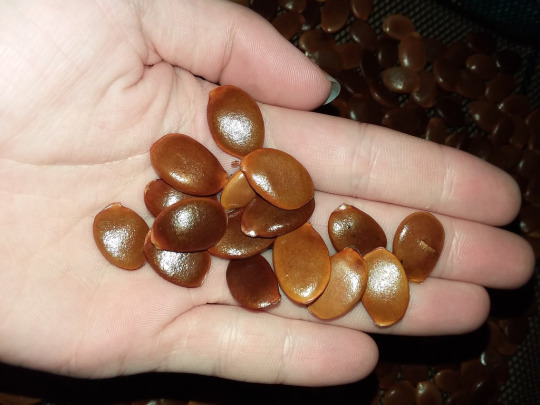
[Image description start: A photo taken with flash, showing a white hand holding sixteen American persimmon seeds. The seeds are all light brown, shiny in the flash from the camera, and are mostly flat like a coin. The seeds are shaped generally like ovals, with small points on one end where the taproot will emerge. Image description end.]
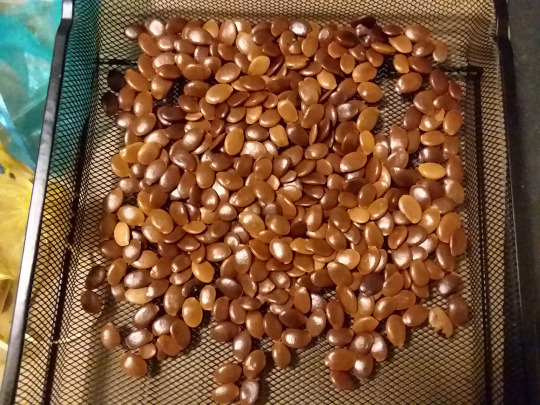
[Image description start: Hundreds of persimmon seeds sitting together on a black wire basket with thin mesh, in different shades of brown. Some are tan, some are medium brown, some are dark brown. Image description end.]
Seeds can be collected from ripe fruit, or collected from the ground after the fruit has been eaten or rotted away.
If you find a persimmon tree in the wild, look around on the ground for the seeds. After you find a few, you'll be spotting them easily.
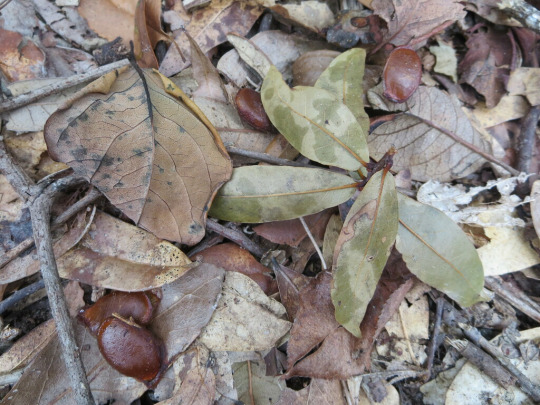
[Image description start: A photo of four persimmon seeds sitting on the ground, which is covered in dead twigs and dried leaves of various types. The persimmon seeds are all dark, warm brown, and shine slightly in the sun. Two are together in the bottom left of the photo, one in the center top is partly below an oak leaf, and one in the top right sits on top of a leaf. Image description end.]
Next up: Seedlings!
First, here's a germinated seed, though not the healthiest example! The whole root should be healthy white. I forget why this one got this way.
(Edit: Nope, I've since been told it's normal for their roots to turn black, so it's not an indicator of poor health :))

[Image description start: A photo of a germinated persimmon seed held in a white hand. The seed is dark brown and covered with dirt, with a white taproot emerging from the pointed end, curving up and then straight down. The taproot turns black halfway down and becomes shriveled. Image description end.]
Next, a seedling germinating in the soil. Persimmon seeds will all start out with a red or pink stem, which usually will form a curve above the soil, with the taproot on one end, and the seed still attached to the other.
If the seed above had been left in the soil, the white curve of the root would have moved upward and turned red, like this one:
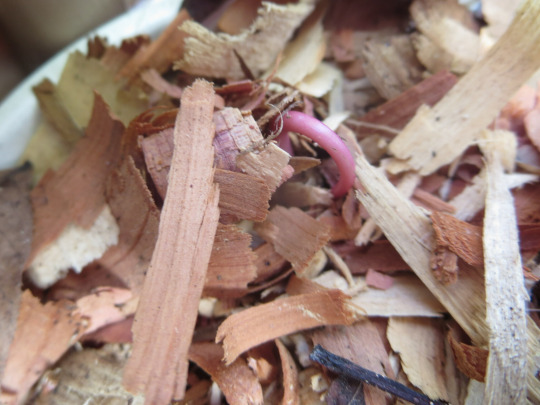
[Image description start: A photo of a persimmon seedling growing in a plant pot with shredded wood for mulch. The seedling's stem is curving up above the surface of the soil, and is solid pale red, pushing the mulch out of its way. Image description end.]
Sometimes, the seedling will get its leaves stuck in the seed if it was buried to shallowly, or the soil has dried out. If this happens, the seed will lift above the soil with the trapped leaves.
If you're gentle, you can usually use your fingernails to help split the seed open and release the leaves. Find the edges where the leaves begin, and gently pull away.
You can also mist the seedling with water, or pile more soil up to once again cover the seed.
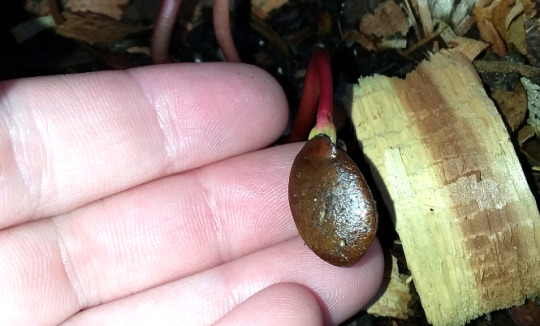
[Image description start. A photo of a persimmon seedling surrounded by shaved wood mulch, with the red stem above the soil, held by a white hand, with the seedling leaves stuck inside the original persimmon seed, which is dark brown and spotted with dirt. Image description end.]
When the seedling has properly emerged above the soil, it will start out with two light green or yellowish, very long seed leaves which will first start out looking like needles:

[Image description start: A photo of a persimmon seedling with woodshaving mulch, with a white hand behind it to provide more contrast. The seedling's stem is bright red, with the tip pointed to the side, where two yellow, needle-like leaves that are almost longer than the stem are positioned. Image description end.]
Very young seedlings will usually start out with the leaves sideways like above, since they've just emerged from the seed and are still getting their bearings.
After a few days, the little needly leaves will uncurl and begin to look like proper leaves. These seed leaves will still be very long and skinny compared to the leaves it will form as it grows.
These will also be the only leaves a persimmon will grow that will be directly opposite eachother on the stem. All new leaves will be alternating, which means if the first starts on the left, the next will be above it on the right, then the left, then right, and so on, forming a zig-zag up the stem.
Here's one seedling from the side and above, showing the opposite seed leaves, and the first alternating leaf that is just starting to form.
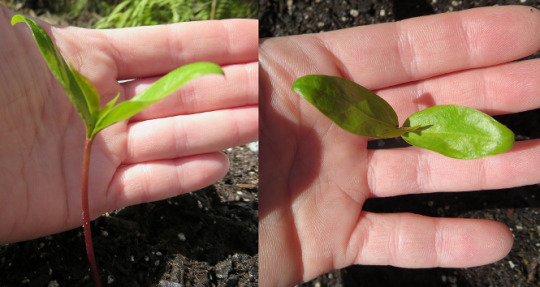
[Image description start: Two photos, side by side, of a persimmon seedling, first shown from the side, then from above, with a white hand behind it to add contrast with the dark soil. The seedling's stem is red, and it has two light green, long leaves, emerging directly across eachother on the stem. In the center, a much smaller leaf is starting to grow. Image description end.]
As the seedlings get older and grow more mature-style leaves, you'll begin to see differences between individuals, which might make identifying them a little confusing if you've only ever had one example to compare to.
With plants grown from seed, like most wild plants are, every individual will be subtly different, and unique in their own way. This is where most cultivars come from of fruit varieties, especially apples – a tree grows from seed with positive traits that make it popular, and that individual is cloned over and over again so that everyone can grow it for themselves.
This is also where cultivars of Japanese persimmons came from! The original tree grew from seed, people really loved it, so they cloned it and grafted it onto other trees, and now you can buy them for yourself and know you'll get the exact same fruit!
Here are two seedlings growing next to each other, whose seeds were collected from the same parent tree. You can see the specific differences, and the general similarities.

[Image description start: Two photos, side by side, of two persimmon seedlings growing next to eachother in a plastic shoebox. The first photo is from the side, showing that they have bright red stems, several inches tall, their original seed leaves, and above them, alternating rows of new leaves. The second photo shows them from above, showing the one on the left has rounder leaves that are tinged red, while the one on the left has skinnier, longer leaves that are solid green. Image description end.]
Some characteristics that will always be the same are: Leaves with smooth edges, without any serrations at all. Serrations are when the edge of a leaf is jagged, like the teeth on a saw, or a knife.
Another feature is that the central vein on the leaf will stand out compared to the rest of the leaf's surface, and in persimmons, might be red, pink, yellow, or sometimes white.
Sometimes the new leaves will be red in color, and that's perfectly normal, you don't need to be alarmed! It depends on the individual, some have it, some don't.
The next picture shows many seedlings older than the two shown above, grown in a larger plastic shoebox. You can see that some have red-tinged leaves, while others have plain green.
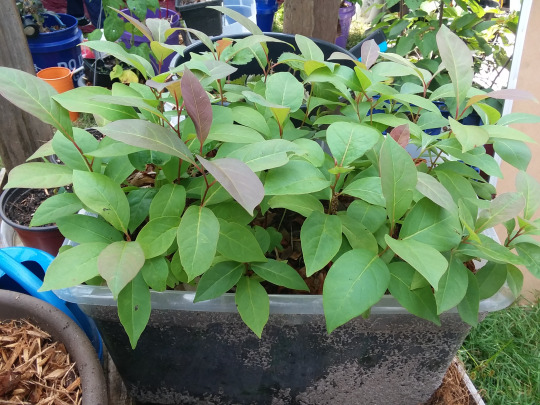
[Image description start: A photo of dozens of persimmon seedlings growing in a deep, clear plastic shoebox, each several inches tall and covered with leaves. Some of the leaves are red, some are green. All the visible stems are still red. Image description end.]
If you are growing persimmons from seed, the deeper the container you can start them in, the faster and healthier they'll grow! This plastic container was wide enough to sow forty seeds in, and deep enough that they could all form good starter roots before being transplanted elsewhere. Most of these I've planted in the woods or other suitable wild areas.
Seedlings will retain their red stem for a few months after they germinate, then it'll turn brown, then, as winter approaches, it'll turn into an actual woody stem. At this point in the tree's growth, you'll be able to see the way the stem literally forms a zig-zag, sometimes subtle, sometimes stark, with a leaf node at each point.
Now for...teenaged plants! No longer a baby seedling, but not yet so tall it's way above your head.
If branches are within your reach, look for a twig:
If it's winter, you will look for dark grey or black, teardrop shaped leaf buds at each point in the zig-zag of the stem:
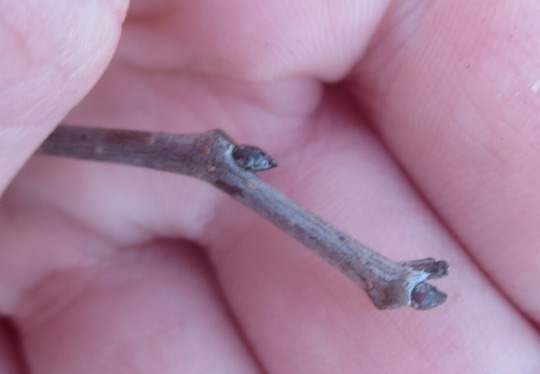
[Image description start: A cropped, close up photo of a dormant persimmon stem held in front of a white hand. The twig is grey-brown, with dark, pointed buds at the corner of a bend, and at the tip. Image description end.]
If it's early spring, around March, you might find some where the buds are starting to open:
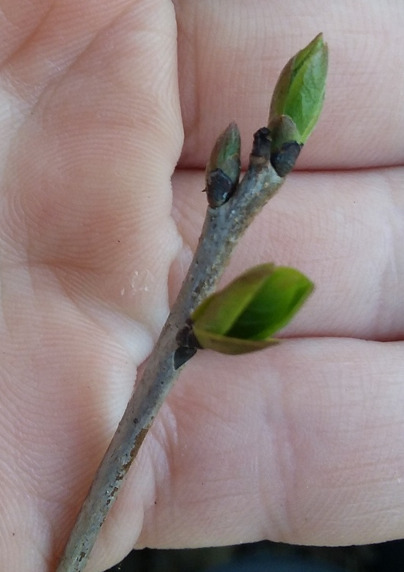
[Image description start: A cropped photo of a persimmon twig, with light grey bark, and light green, folded leaves starting to emerge from the dark buds at each node. Image description end.]
If it's later in Spring, usually late March, you should start to look for small, light green, rounded leaves like this:

[Image description start: A photo of a persimmon twig held up by a white hand, with sunlit trees in the background. Many small, light green leaves emerge from the grey twig on light green, new-growth stems, branching off as they grow. The leaves closer to the twig are deeper green, and those at the very end of the new growth are almost translucent, and slightly yellow. All have smooth edges, with light green central leaf veins. Image description end.]
Unlike seedlings, the new growth on persimmons over a year old will start out light green until it turns to wood later in the season.
As the season progresses, the leaves will take on more even shapes, always alternating on the left and right side of the stem, forming the zig-zag we talked about earlier.
Here's a new-growth stem from April:

[Image description start: A photo of a persimmon stem held up by a white hand ,with dried leaves and sticks covering the ground in the background. The leaves on the plant are all light green, with smooth edges, and shaped like a pointed oval. The leaf-stem on each leaf is pale pink, fading to yellow, then to white, on the central leaf vein. The new-growth twig is light green. Image description end.]
And here's one from June with red central leaf veins. Each individual is different, so you should be prepared to see different color variations, though they'll always keep the smooth edges, central leaf vein that is visible, alternating zig-zag pattern, and pointed buds at the base of each leaf.
This plant was growing in more shade than most of the other individuals shown in photos here, so its leaves are darker green.
Persimmons can thrive in full sun and part shade, and even grow in full shade, and their leaves will change to be lighter or darker depending on the levels of sunlight, and depending on the individual. Plants in full sun don't have to work as hard to photosynthesize, so they'll usually be lighter green, reflecting a lot more away. Those growing in shade, though, want to grab as much light as they can, so will tend to be darker so they can absorb more light.
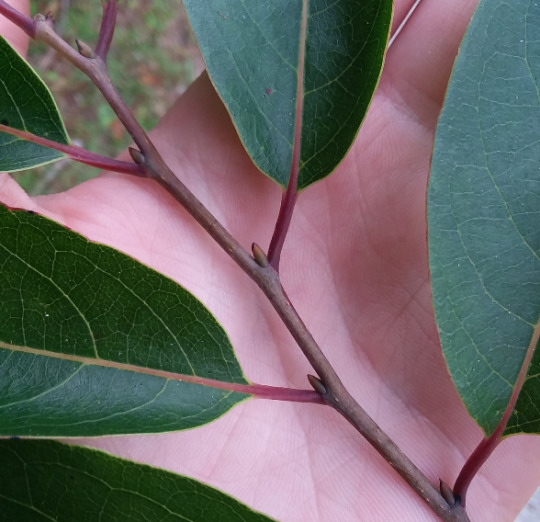
[Image description start: A close up photo of a persimmon stem, held against a white hand. The stem is dark brown, with dark brown pointed buds at the base of each leaf, with slightly reddish tips. The leaves are dark green, with the leaf-stem dark pink, and the central leaf-vein fading from pink to yellow. Image description end.]
The trunk of the tree at this point will usually be a light brown or grey, with lighter raised lenticels, which are how the tree breathes. On persimmons, they look like little dots or dashes.
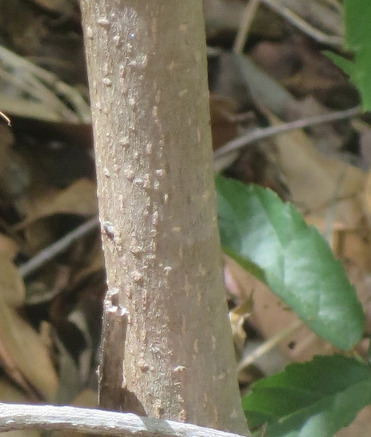
[Image description start: A cropped photo of the trunk of a young persimmon, with dried leaves and some brambles in the background. The trunk is very light, grey-brown, with lighter tan, small lenticel lines scattered over it. Image description end.]
As the trees get older, their bark will become craggier and craggier, until it forms the very distinctive “alligator skin” that mature persimmons have.
Here's a photo of a young adult tree, old enough to flower, but still small enough I can put both my hands around the trunk:
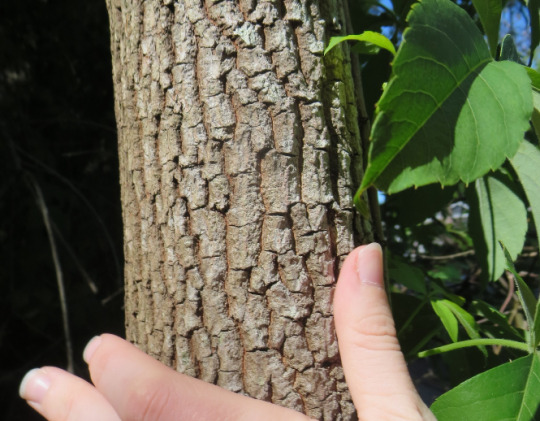
[Image description start: A cropped photo of a young-adult persimmon, with a white hand at the bottom partly wrapped around it. The bark is very light grey-tan, with deep fissures running up and down and across, forming square-ish raised sections, with orange in the fissures between them. Some serrated leaves of Virginia creeper is next to the hand. Image description end.]
This tree is, for future reference, a male.
Here's another tree of similar age, though this one is female. But
we'll get to those details later! Sex does not determine the type of bark, I just thought I'd mention it.
Remember that each individual is different, so even if you have a male tree with X kind of bark and a female with Y kind of bark, that doesn't mean that's a real pattern! It's just up to the genetic lottery.
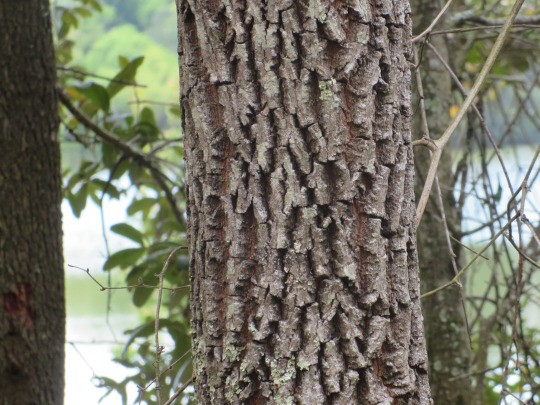
[Image description start: A photo of a young-adult persimmon tree. Its bark is light grey, with deep vertical fissures that are red-orange in the center, most of them running up and down, and a few shallower ones running left to right, giving the bark a craggy, ropey appearance. Image description end.]
The older the tree gets, the craggier the bark will become! The raised sections will form more square-like shapes rather than stripes or ropes.
Here's one example, by kent_ozment on iNaturalist.org:
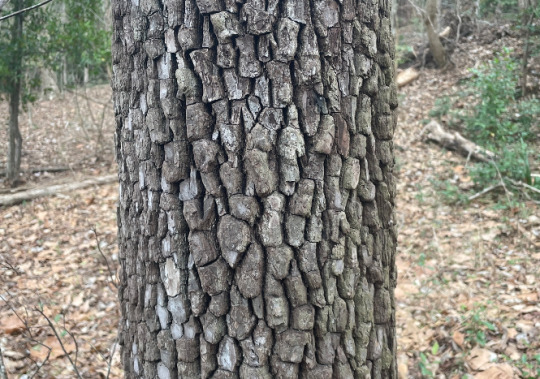
[Image description start: A cropped photo of an adult persimmon tree in the daytime, with the ground behind it covered in brown dried leaves. The bark is grey, with deep fissures running between and around large chunks of bark. Image description end.]
And now, we can talk about telling male trees from female!
Both trees produce flowers, which are great for pollinators, but only females produce fruit.
Male trees produce pollen, which is then carried by insects to the flowers of a female tree, pollinating the female's flowers and allowing it to form viable seeds that will grow into the next generation.
Lets start out with flower buds.
Like leaves, flower buds emerge at each node on the stem, or each point on the zig-zag.
The flower buds start out green, and can blend in with the leaves, especially if they're higher up in the tree.
Here's a zoomed in photo of female flower buds, high up on an adult tree, just starting out, on April 30th. Note that there's one bud per node.

[Image description start: A zoomed photo of a persimmon's stems, backlit by the sun. The leaves are still small and light green in their new spring growth, and at the base of each leaf is a small darker silowet, like a teardrop. Image description end.]
(Yes, I am spelling it silowet. I am officially staging a one-othran revolt against the overly complicated accepted spelling.)
And here's some male flower buds, and note that there are several buds per node.
Male trees form more flowers per part of tree than females do, because the male puts all its energy into producing as much pollen as possible, to attract insects that will carry that pollen to a female tree.
This photo is from April 17th.
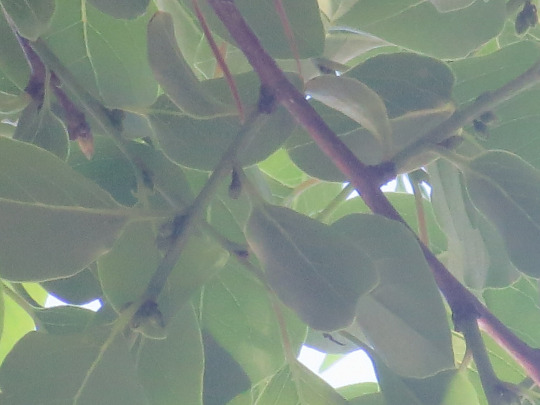
[Image description start: A zoomed photo of persimmon stems overlapping against a bright sky, casting them into shadow. The leaves are still small, in their spring growth. At the base of each leaf are small, darker flower buds like pointed ovals, with anywhere from one to three at each node. Image description end.]
Later the buds will turn white and yellow, then start to open, and become more recognizable as flowers.
Here's a female flower bud that's closer to opening. The green cap behind it is called a calyx, and is what you see when the flower bud is still fully closed. This calyx, or cap, remains on the fruit even after it falls, and will dry and turn black.
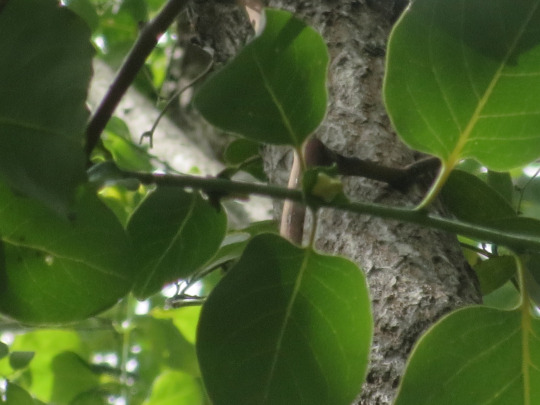
[Image description start: A zoomed photo of a persimmon stem with larger, spring-green leaves, with the focus on a female flower bud, which has a square-like calyx behind it, and its white petals still shut, pointed outward like a small pyramid. Image description end.]
Here's some female flowers at eye level, with the photo by kcthetc1 on iNaturalist.org
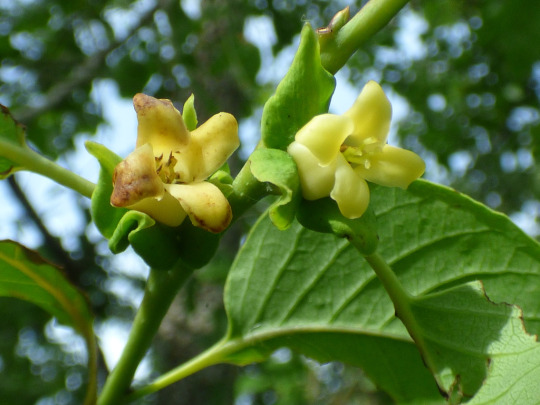
[Image description start. A close up photo showing two female persimmon flowers, each at the base of a different leaf. The flowers have four yellow rounded petals, with large green leaf-like caps clasping the base. Image description end.]
That large calyx is also a way of telling female trees from males, since it's much larger on females.
And here's some male flowers, along with some still-closed flower buds:
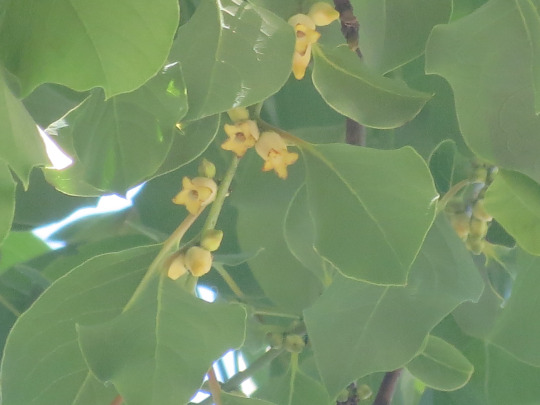
[Image description start: A zoomed photo of several persimmon twigs, with light green leaves, each with several flowers or flower buds emerging from the same node. The open flowers are thin, shaped like vases, with four pointed petals at the opening. Less mature flower buds are yellow-white, and pointed. Further back can be seen more flower buds that are still green. Image description end.]
And some male flowers at eye level, with the photo by kcthetc1 on iNaturalist.org.

[Image description start: A close up photo of several male persimmon flowers, with two or more hanging from the base of each leaf. The flowers are shaped like skinny, upside-down vases, with white sides and short, curled yellow petals, with small green bases holding them onto the stem. Image description end.]
And a great photo showing just how many male flowers can crowd onto a small section of branch:
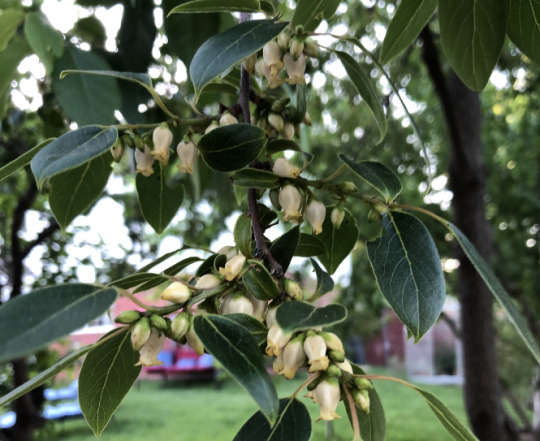
[ID: A photo of a male persimmon tree's branch at eye level, with several dozen open white flowers and closed green flower buds crowding the wooden stem below the leaves all the way up until the branch leaves the frame of the photo. Image description end.]
The flowers are very popular with native bees like bumblebees, carpenter bees, and more. All the flowering-age trees near me have their flowers at least 20ft off the ground, so I haven't been able to closely observe any of the visiting species.
Hopefully in a few years when my seedlings are old enough to flower, I'll be able to tell you more about the species that visit them :)
The male flowers will drop to the ground below the tree once they're too old, and you can find them if you look carefully, or if there's a convenient sidewalk:
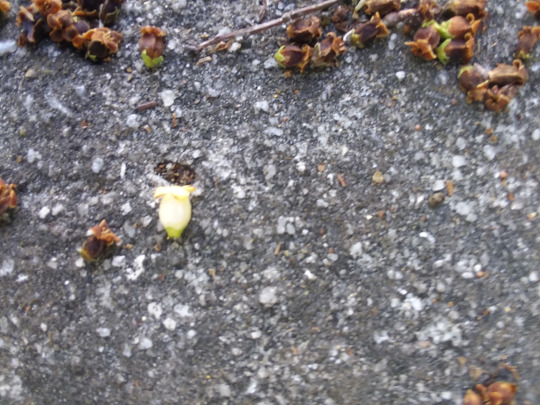
[Image description start: A slightly blurry photo of a dark sidewalk, covered with many brown, shriveled male persimmon flowers, with their smaller, clasping calyxs still green. One single fresher flower sits near the center of the photo, the petals still white, not yet baked by the sun. Image description end.]
Beneath female trees, you'll be able to find unpollinated flowers, as well as aborted fruits. These ones were from July:
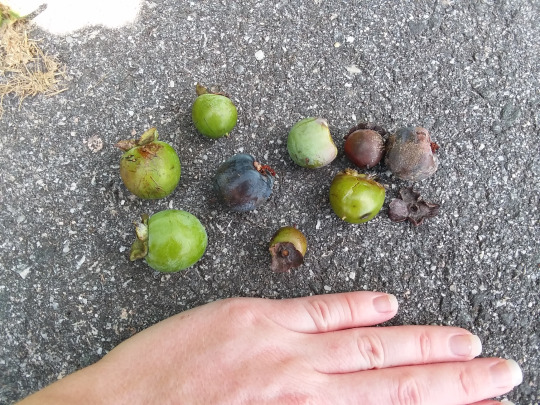
[Image description start: A photo of nine unripe persimmon fruits of various sizes sitting on a paved sidewalk next to a white hand for scale. The largest fruit is smaller than a golf ball, the smallest is about the size of a marble. Most of them are green, but two are brown, and one has turned almost black. Most of them still have their green calyxs attached on the top, still green on some, and brown and dry on others. Image description end.]
There's a lot of reasons a tree might drop some unripe fruits, like improper pollination, insect damage, and simply strong winds. Don't be concerned or disappointed if you find some dropped fruits under the tree, they'll usually be plenty more that will fully ripen!These fruits absolutely cannot be eaten at this stage of unripeness, so don't try unless you want to taste something absolutely disgusting. You can, however, dissect them with a knife, or just squishing under your shoe, to see if they've got seeds in them so you can see what they look like.
Here's another handful of early-dropped fruits from the same group of trees in August. See how they've gotten bigger overall?
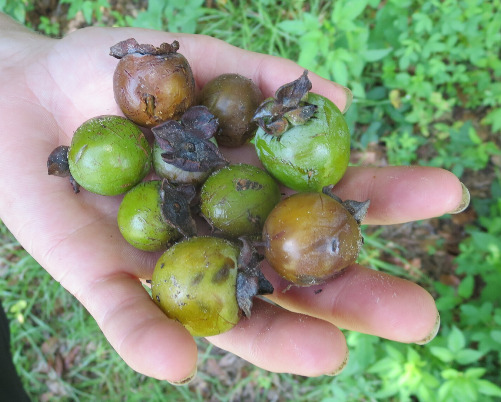
[Image description start: A photo of a white hand holding nine unripe persimmons, with green plants visible on the ground in the background. The smallest fruit is the size of a gumball, the largest is about the size of a golf ball. Most of them are green, one is yellow-green, and a few are brownish. All but two still have their calyxs attached, now shriveled and black. Image description end.]
Any time you find unripe fruits on the ground, you can look up (or maybe slightly to the side, if you're on a hill or there have been strong storms recently) and see if you can spot more fruit on the tree.
Here's some fruits still attached to the tree, from the same tree and day as the photo above. Please also note the webworm moth nest, and the leaves that have been eaten! Webworm moths love persimmons, and can help you identify them!
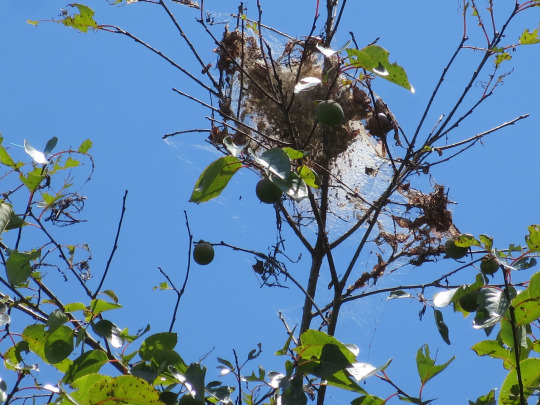
[Image description start: A zoomed photo of a persimmon's top branches against a clear blue sky. Many of the twigs are missing leaves, with some of the leaves visibly missing sections from caterpillar bites. On the very top fork of branches is the grey web of webworm moths. Scattered on the branches in front and below the web are unripe fruits, which are dark green against the sky. The leaves that have not been eaten have black spots on them. Image description end.]
And you notice those black spots?
They're another great way to identify persimmons later in the year! You don't need to be worried or try to get rid of them, the trees do just fine on their own.
Persimmon leaves will start to change color for fall in late October, going from green to yellow while the fruit continues to ripen, and starts to fall properly.
If the persimmon tree is growing near evergreen species, or species that hang onto their leaves longer, it will stand out very nicely against the green.
Here's a photo of one of the persimmon trees with its leaves turning yellow, with several species of southern oaks on either side, which keep their leaves longer. In front of the persimmon is a large shining sumac, which are the red leaves you can see.
[This is the part where tumblr won't let me add any more photos. RIP]
Imagine a photo of a persimmon tree in a line of otherwise green trees, with its canopy mostly yellow. Below it is a sumac tree with green and red leaves.
And now please imagine a close up of some of those yellow leaves, with fruit, and another webworm web!
Imagine a zoomed photo of over a dozen persimmons in various stages of ripeness hanging from a persimmon tree, whose leaves are yellow or green, covered in red or black spots. A web with dead leaves inside sits in the center of the frame behind the fruits. The fruits range in color from yellow, to orange, to deep pink.
And finally...
Ripe fruits!
Imagine a photo of a white hand holding up two ripe persimmons. Both are orange and slightly transluscent, with their caps shriveled and black.
These will start to fall usually in October, but can cling to the tree for a while. If you're able to, laying a tarp below the tree to catch them will help keep them clean. If not, make sure to rinse them well before eating.
The skin is edible, but the seeds and cap are not.
The fruit should be very soft to the touch, almost like goo. If it's hard, don't eat it yet! It'll still be astringent. Let it sit in the sun until it ripens more.
If you are collecting lots of fruits, plan ahead if possible, and save your egg cartons! Put one persimmon in each spot that holds an egg, and it'll keep them from getting squished while you're moving them.
The ripe fruits will be eaten by many species of animals, including deer, raccoons, and even black bears if you have them in the area!
Unless the tree is on private property where wildlife can't get to it, always make sure to leave behind more than you take! Wildlife need the food too, and they'll help the species spread through their scat.
If you're growing the tree in your own yard, do whatever you want, lol.
You and your friends and family can also help persimmons spread by planting the seeds in suitable wild areas, or in containers to cold stratify over the winter, as you collect them from the fruit.
And if you don't want to grow the trees yourself, don't throw the seeds away! They're easy to clean after you eat the fruit. Simply allow them to dry once they're clean, and next time you go out hiking or walking near wild areas, shove some in your pockets and throw them as you go!
You can also see if anyone in your local community would like them, or even sell them online.
Persimmons can be eaten whole (spitting out the seeds), or made into jellies, jams, and a lot of other stuff.
Recipes!
I don't have any persimmon-specific recipes, but here's a good recipe for cheesecake that even I like, and tastes amazing with added fruit!
If I find more recipes that work well with persimmons, I'll add them here in later updates for this guide!
Easy Cheesecake:
Homemade Cheesecake Crust:
At least 1 1/2 cups of cinnamon gramcrackers, crushed as small as you can get them. We usually just do one pack of crackers rather han measure.
1/4 cup sugar
2 teaspoons vanilla (and yes, we use the cheapest vanilla extract we can get.)
1 stick of salted butter, melted
Step 1 of 1: Mix all prepared ingredients in a large bowl, then press into pie dish.
You can also just buy a premade crust, but they don't have as much flavor. With this recipe, the crust is half the delight.
Cheesecake filling:
Two eight-ounce packages of cream cheese, At Room Temperature.
Sit them out hours ahead of time if it's cold in your kitchen. They need to be warm if you want the cheesecake to be smooth. If they're still cold, it'll be lumpy, which isn't as good of a texture. You can technically melt them slowly in the microwave but that's a lot of effort.
2/3s cup of powdered/confectionier's sugar...or just regular sugar if you're lazy like we are.
2 large eggs, at room temperature
One teaspoon of vanilla
However much fruit you want to mix in. You can literally add as much or little as you want as long as it'll fit in the pie crust.
Preheat oven to 350 degrees Fahrenheit, or 176 Celsius
Step 1: Mix the room temperature cream cheese with the sugar until smooth.
Step 2: Add eggs and vanilla, and combine.
You can either add fruit now, mixing it in, or put a layer directly on the crust, with the cheesecake filling on top, or reversed!
Bake for 30 minutes, remove to wire rack and cool. Keep, covered, in refrigerator until ready to serve, and refrigerate or freeze leftovers.
#described images#American persimmon#diospyros virginiana#plant identification#tree identification#wild foraging#wild edibles#wild fruit#edible fruit#persimmon#common persimmon#foraging#gardening#seed saving#diospyros#photography
4 notes
·
View notes